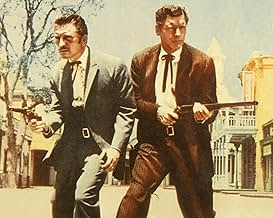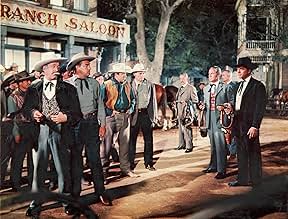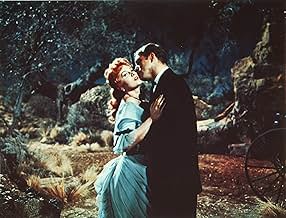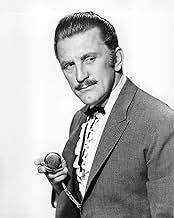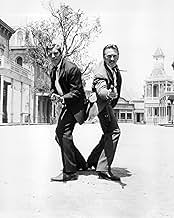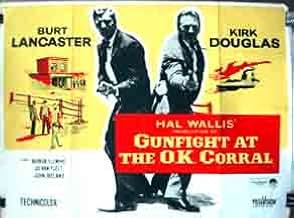Wyatt, comisario de Dogde City, un hombre famoso por su sentido de la honradez, y Doc Hollyday un jugador entregado a la bebida, traban una buena amistad pese a sus diferencias para enfrenta... Leer todoWyatt, comisario de Dogde City, un hombre famoso por su sentido de la honradez, y Doc Hollyday un jugador entregado a la bebida, traban una buena amistad pese a sus diferencias para enfrentarse a la banda de los Clanton en OK Corral.Wyatt, comisario de Dogde City, un hombre famoso por su sentido de la honradez, y Doc Hollyday un jugador entregado a la bebida, traban una buena amistad pese a sus diferencias para enfrentarse a la banda de los Clanton en OK Corral.
- Dirección
- Guionistas
- Elenco
- Nominado a 2 premios Óscar
- 3 premios ganados y 4 nominaciones en total
- Shanghai Pierce
- (as Ted DeCorsia)
- Dirección
- Guionistas
- Todo el elenco y el equipo
- Producción, taquilla y más en IMDbPro
Opiniones destacadas
Now personally I think their careers show that both of these guys knew exactly what they were doing in guiding their own destinies. This film is a great example of it. It was deservedly a critical hit and a moneymaker.
No film has ever been made that completely told accurately the story of the famous gunfight, least of all this one. But it sure captures the spirit.
I think both of these guys could have played each other's part and the film still would have been a winner. The problem with playing Wyatt Earp is that he's usually such a straight arrow on screen or on television that the main job of the actor is to keep from making him sound like Dudley Doo-Right. Burt Lancaster is capable enough and did it, but Wyatt Earp maybe one of the least complex roles he ever essayed.
Kirk Douglas though is the best Doc Holiday I've ever seen portrayed. Doc Holiday is a brooding, consumptive alcoholic who's also a woman batterer. He treats Jo Van Fleet like garbage and her responses to him is responsible for several of the plot twists. As I've said before Douglas can flip into rage better than any other actor ever. Just watch him with Van Fleet after the youngest Earp brother has been killed.
Today we would call Jo Van Fleet a battered spouse even though she and Douglas are living common-law. Her's is the next best portrayal in the film besides Kirk Douglas.
Rhonda Fleming has little to do except look coquettish and beautiful as the lady gambler who Lancaster falls for. But that was usually enough for her public. It's ironic that she's playing a liberated woman for 19th century and Fleming's politics are quite right wing and Lancaster her very traditional 19th century man was a noted political liberal.
And of course the unbilled co-star is Frankie Laine singing that wonderful title song by Dimitri Tiomkin and Ned Washington. Tiomkin was one of the best of movie composers, his music gave that extra oomph into a lot of good movies, making them great.
Lancaster, continuing his rule of alternating between heavy drama and action films, researched the historic Earp extensively, speaking to many who knew him, and his performance is restrained and assured. Douglas, on the other hand, fresh from playing Vincent Van Gogh in 'Lust for Life', knew he needed a splashy hit film, and played Doc Holliday as larger than life, swaggering, diseased, and charismatic. His portrayal is far closer in spirit to the interpretations of Holliday by Val Kilmer, in 'Tombstone', and Dennis Quaid, in 'Wyatt Earp', than Victor Mature, in John Ford's 'My Darling Clementine'.
The film, co-written by Leon Uris, author of 'Exodus', is a historically fanciful but very entertaining exploration of the friendship between Earp and Holliday, as the lawman moves from Dodge City to Tombstone, followed by the gambler, covering a 'blood debt', after Earp saves his life. The climax is, naturally, the infamous gun battle between the Earps (with Holliday) versus the Clanton family and their allies. While purists will quickly note that the shoot-'em-up presented is totally fabricated (watch 'Wyatt Earp' or 'Tombstone' if you want accuracy), it certainly is rousing!
Other aspects of the film to enjoy...Dimitri Tiompkin's magnificent musical score, highlighted by Frankie Laine's unforgettable performance of the title tune, throughout the film...Excellent supporting players, including Jo Van Fleet as Holliday's mistress, John Ireland as evil Johnny Ringo, a young Dennis Hopper as Billy Clanton, and Rhonda Fleming as the gambler girlfriend of Wyatt (based on Earp's actual wife, Josie)...Cameos by Kenneth Tobey as Bat Masterson, DeForest Kelley as Morgan Earp, Martin Milner as James Earp, and Frank Faylen as the corrupt sheriff.
The director, John Sturges, revisited the Earp saga some years later in 'Hour of the Gun', with James Garner as Earp, and Jason Robards as Holliday, but while the later film may be more correct, historically, 'Gunfight at the O.K. Corral' is a far more enjoyable film.
I strongly recommend it to any western fan!
"Gunfight at the O.K. Corral" has some of the Sturges virtues, but not all It doesn't however disappoint when it comes to the crunchthe gunfight itself This is magnificently staged It probably equals anything that law and order movies have produced in set-piece battles
The film also focuses on the friendship between Earp and Holliday and the good will of two different kinds of men... Earp, is an honest lawman with authority, and Holliday, a gambler with a 'real big hate for the law.'
The two characters are powerful, strong, and at the same time compassionate, with respect and dignity... Holliday's character as the black sheep, is much more interesting than the straight marshal who is at the same time the lawman, the judge and the jury.' The main assets of the motion picture are Lancaster and Douglas, two great stars conscious of their potentialities with excellent ability...
Douglas is impressing and brilliant as the troubled sick Doc Holliday and Lancaster is confident, solid and likable as Wyatt Earp... The mirror scene, in the beginning of the film, is great: Douglas, cool and steady, is ready for action observing carefully in the mirror the sharp feature and narrow steely eyes of Lee Van Cleef who is so anxious to kill him with a small gun hidden in his left boot...
Fine performances by a first-class cast heighten the interest: Rhonda Fleming is ravishing as the redhead lady gambler; Jo Van Fleet is very effective as the jealous lady, torn between Ringo and Holliday; Earl Holliman is good as the naive deputy who 'picks up the hardware as soon as the cowboys hit town;' John Ireland is unforgettable with his slight stoop and menacing walk; Lyle Bettger is strong as Ike Clanton, the organizer of the toughest bunch of gunslingers; Dennis Hopper is difficult and rebellious as the young Clanton who can't take the advice of the marshal; and Jack Elam is threatening as the tall and lean man with an evil leer...
Dimitri Tiomkin's great score back up the "Gunfight at the O.K. Corral," a pure Western, magnificently photographed by Charles Lang in VistaVision and Technicolor...
John Ireland has been twice on the losing side of the Corral incident... The first time as Billy Clanton in John Ford's "My Darling Clementine."
To be sure, it contains fine things. Burt Lancaster is stolid and unyielding as hard lawman Wyatt Earp. Sturges films him with the camera at ground level as he rides onto the screen, making him seem superhuman in his larger-than-life moral certainty. He faces down the armed drunk without the faintest twitch of fear, the embodiment of a strong, righteous enforcer of the law. The friendship between the paragon and the wastrel is cleverly done, with Earp and Holliday (Kirk Douglas) each seeing something to admire in the other, very different, man. Character is also to the fore as a plot-driver when Kate Fisher (Jo Van Fleet) is forced by the dynamics of her relationship with the Doc into ever more wretched behaviour. By comparison, the Earp-Laura love story is cold and staid. Both Lancaster and Rhonda Fleming are terrific to look at, but hard to warm to. Though the film takes an eternity to get to the shoot-out which is its raison d'etre, when the climax finally comes the suspense is built superbly. In a nice symmetry, we see the women of both sides dreading the fatal clash as Ma Clanton and Virgil's wife separately mourn the departure of their respective menfolk. Douglas made a career out of playing generous-spirited bad guys, and one of the best things in this film is Doc Holliday's heroic effort of will, rising from his sickbed to stand beside his friend in the face of mortal danger. Shot in a rich Technicolor palette, the film's images are strong and clean, and at times even beautiful, for example the barn fire, or the approach of the Earp faction, with Cotton standing facing them, his body framed by the corral building.
Other elements are not so well done. Wyatt is too unrelenting a hard man to win the audience's unqualified sympathy, as in the scene when he tells the all-too-human Cotton, "If you can't handle it any more, turn in your badge." The Frankie Laine ballad, almost de rigeur in 1950's westerns, is simply not up to scratch ("Boot Hill, Boot Hill, so cold, so still ...") There is an ugly shadow eclipsing Ike Clanton's face throughout his most important scene. Billy (a very young Dennis Hopper) is 'converted' by Wyatt far too easily.
There exists a wide spectrum of opinion on the question of how loyal a work of fiction should remain to the historical event which inspired it. One camp would argue that the artist has total freedom to rework a popular legend such as The Gunfight, while the other extremity would insist on documentary accuracy. This film is interesting, in that it takes a well-known incident for which contemporaneous records abound, and virtually disregards the historical truth.
In the film, the decent, clean-shaven Earp boys are merely 'doing what a man has to do'. We know that the Clanton-McLaury gang is mean and duplicitous, and that there will have to be a showdown between Right and Wrong. The shoot-out, when it comes, happens over several minutes of time on a clear, bright day. There is an athletic battle of movement, with the Earps in particular manoeuvring for position, and finally trapping the Clantons in and around a burning wagon. The strategic intentions of the good guys are clear and easy to follow.
The reality of October 26, 1881 was quite different. Two gangs of walrus-mustachioed men confronted each other, standing face-to-face in a built-up street. The shooting lasted a maximum of 30 seconds, and when the smoke cleared, three of the so-called "cowboy faction" lay dead or mortally wounded, whereas the Earp faction sustained only minor wounds. Wyatt was totally unharmed. Ike Clanton and Billy Claiborne, two of the cowboy leaders, had in fact run away when the guns opened fire.
This was no tussle between Good and Evil. Wyatt Earp was not a US Marshall, as the film tries to insist. He was Virgil's assistant with purely local authority, little more than his brother's pinch-hitter. Doc Holliday held no office of any kind. This was a clash between two Americas - the Earps representing the urban, northern, republican culture which had won the Civil War, while the Clantons stood for the freebooting, democratic, open-range mentality whose sympathies lay with the vanquished South.
A motion picture has a span of something like 90 minutes in which to set out its stall. Perhaps such a narrow intellectual space imposes so many constrictions that the true flavour of a historic event can never be properly represented. Or maybe the limitations of the medium set the film-maker free to create a better, more poetic "reality". I don't know the answer. There probably isn't one.
¿Sabías que…?
- TriviaThe legendary gunfight took place on October 26, 1881 and lasted thirty seconds, resulting in three dead men after an exchange of thirty-four bullets. The fictionalized gunfight in this movie took four days to film, and produced an on-screen bloodbath that lasted five minutes.
- ErroresWhen the OK corral fight commences, one of the Earp brothers fires a shotgun at the wagon the Clanton gang is in. Ike yells "shotgun" and they duck. The pellets from the shotgun blast are clearly seen hitting the canvas on the wagon, forming a large circle with the many different pellet holes. Two scenes later when they return to the same canvas, all the pellet holes are gone.
- Citas
Wyatt Earp: All gunfighters are lonely. They live in fear. They die without a dime, a woman or a friend.
- ConexionesFeatured in Entertainment This Week Salutes Paramount's 75th Anniversary (1987)
- Bandas sonorasGunfight at the O.K. Corral
(1957)
by Ned Washington and Dimitri Tiomkin
Sung by Frankie Laine
A Columbia Recording Artist
Selecciones populares
- How long is Gunfight at the O.K. Corral?Con tecnología de Alexa
Detalles
- Fecha de lanzamiento
- País de origen
- Idioma
- También se conoce como
- Gunfight at the O.K. Corral
- Locaciones de filmación
- Old Tucson - 201 S. Kinney Road, Tucson, Arizona, Estados Unidos(Tombstone in the opening scene is the same bridge and town as "Rio Bravo" w/John Wayne and was filmed in "Old Tucson".)
- Productora
- Ver más créditos de la compañía en IMDbPro
Taquilla
- Presupuesto
- USD 2,000,000 (estimado)
- Tiempo de ejecución2 horas 2 minutos
- Relación de aspecto
- 1.85 : 1
Contribuir a esta página



